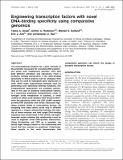| dc.contributor.author | Desai, Tasha A. | |
| dc.contributor.author | Rodionov, Dmitry A. | |
| dc.contributor.author | Gefland, Mikhail S. | |
| dc.contributor.author | Alm, Eric J. | |
| dc.contributor.author | Rao, Christopher V. | |
| dc.date.accessioned | 2012-09-17T20:59:07Z | |
| dc.date.available | 2012-09-17T20:59:07Z | |
| dc.date.issued | 2009-03 | |
| dc.identifier.issn | 0305-1048 | |
| dc.identifier.issn | 1362-4962 | |
| dc.identifier.uri | http://hdl.handle.net/1721.1/73031 | |
| dc.description.abstract | The transcriptional program for a gene consists of the promoter necessary for recruiting RNA polymerase along with neighboring operator sites that bind different activators and repressors. From a synthetic biology perspective, if the DNA-binding specificity of these proteins can be changed, then they can be used to reprogram gene expression in cells. While many experimental methods exist for generating such specificity-altering mutations, few computational approaches are available, particularly in the case of bacterial transcription factors. In a previously published computational study of nitrogen oxide metabolism in bacteria, a small number of amino-acid residues were found to determine the specificity within the CRP (cAMP receptor protein)/FNR (fumarate and nitrate reductase regulatory protein) family of transcription factors. By analyzing how these amino acids vary in different regulators, a simple relationship between the identity of these residues and their target DNA-binding sequence was constructed. In this article, we experimentally tested whether this relationship could be used to engineer novel DNA–protein interactions. Using Escherichia coli CRP as a template, we tested eight designs based on this relationship and found that four worked as predicted. Collectively, these results in this work demonstrate that comparative genomics can inform the design of bacterial transcription factors. | en_US |
| dc.description.sponsorship | National Science Foundation (U.S.) (CAREER award CBET- 0644744) | en_US |
| dc.description.sponsorship | United States. Dept. of Energy | en_US |
| dc.description.sponsorship | Howard Hughes Medical Institute (55005610) | en_US |
| dc.description.sponsorship | Russian Foundation for Basic Research (08-04-01000) | en_US |
| dc.description.sponsorship | Russian Academy of Sciences | en_US |
| dc.language.iso | en_US | |
| dc.publisher | Oxford University Press | en_US |
| dc.relation.isversionof | http://dx.doi.org/10.1093/nar/gkp079 | en_US |
| dc.rights | Creative Commons Attribution Non-Commercial | en_US |
| dc.rights.uri | http://creativecommons.org/licenses/by-nc/2.5 | en_US |
| dc.source | Oxford | en_US |
| dc.title | Engineering transcription factors with novel DNA-binding specificity using comparative genomics | en_US |
| dc.type | Article | en_US |
| dc.identifier.citation | Desai, Tasha A. et al. "Engineering transcription factors with novel DNA-binding specificity using comparative genomics." Nucleic Acids Research 37(8)(2009): 2493-2503. | en_US |
| dc.contributor.department | Massachusetts Institute of Technology. Department of Biological Engineering | en_US |
| dc.contributor.department | Massachusetts Institute of Technology. Department of Civil and Environmental Engineering | en_US |
| dc.contributor.approver | Alm, Eric J. | |
| dc.contributor.mitauthor | Alm, Eric J. | |
| dc.relation.journal | Nucleic Acids Research | en_US |
| dc.eprint.version | Final published version | en_US |
| dc.type.uri | http://purl.org/eprint/type/JournalArticle | en_US |
| eprint.status | http://purl.org/eprint/status/PeerReviewed | en_US |
| dspace.orderedauthors | Desai, Tasha A.; Rodionov, Dmitry A.; Gefland, Mikhail S.; Alm, Eric J.; Rao, Christopher V. | en_US |
| dc.identifier.orcid | https://orcid.org/0000-0001-8294-9364 | |
| mit.license | PUBLISHER_CC | en_US |
| mit.metadata.status | Complete | |
